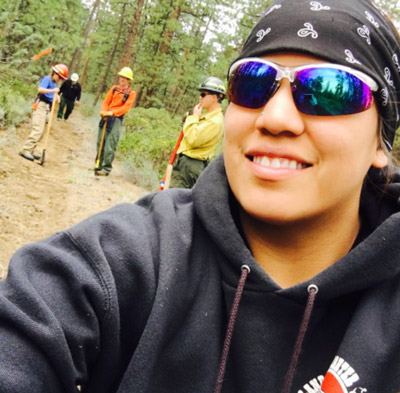You are viewing ARCHIVED content published online before January 20, 2025. Please note that this content is NOT UPDATED, and links may not work. Additionally, any previously issued diversity, equity, inclusion or gender-related guidance on this webpage should be considered rescinded.
Author: Robyn Broyles, Kim Kelly
The Central Oregon Ecological Training Exchange (TREX) is a two-week learning program designed to provide two-way training and learning for fire practitioners, land stewards and resource specialists from a wide variety of backgrounds and organizations.
Through the Fire Learning Network, a joint project of the Nature Conservancy, the USDA Forest Service and the several agencies of the U.S. Dept. of Interior and conservation staff from across the United States gathered in the Deschutes National Forest April 25- May 6, 2016 to learn from each other and share expertise in prescribed fire management. Yolanda Yallup was one student who attended the TREX training.

Burn patters used at TREX. Photo by Yolanda Yallup.
A central tenet of the training is that everyone is a participant, teacher, and student. Students interacted with land managers, local scientists and fire specialists throughout the training and all were able to learn from each other explains Yallup. It was my experience says Yallup that “the training not only provides students with life experiences, it also exposes diverse viewpoints, paradigms and values not always held by everyone. In seeing others perspectives and experiences, I feel I’m better able to bridge difference and find common ground with someone who may not think as I do.
The first week was spent in the classroom, learning about the ecological and social landscapes of fire-adapted Ecosystems. Fire effects and treatment effectiveness monitoring, communications and public outreach were also covered.
Then, we were able to put that knowledge into practice.
One exercise we had to do was staff a stand at a restaurant to inform the public about upcoming prescribed fires. This outreach helped build local relationships and created an opportunity to talk with the public about what prescribe fires are, why it was being done and highlight some of the benefits it would have for the forest.
Then we got to conduct the burn, learning how different lighting methods help control the fire. Like other prescribed fire, some were designated to hold the fire to make sure it did not cross over to where we didn’t want it to go, while others were lighters. When the fire was done, we mopped it up to make sure it was out. Finally, when we were done, we evaluated how effective the fire was and whether or not the burn successfully accomplished our goals.
Overall, says Yallup, “TREX was for everybody at every level, we all left with our eyes opened a little wider, with a better understanding of prescribed fire.”
For Immediate Release: October 1, 2016


